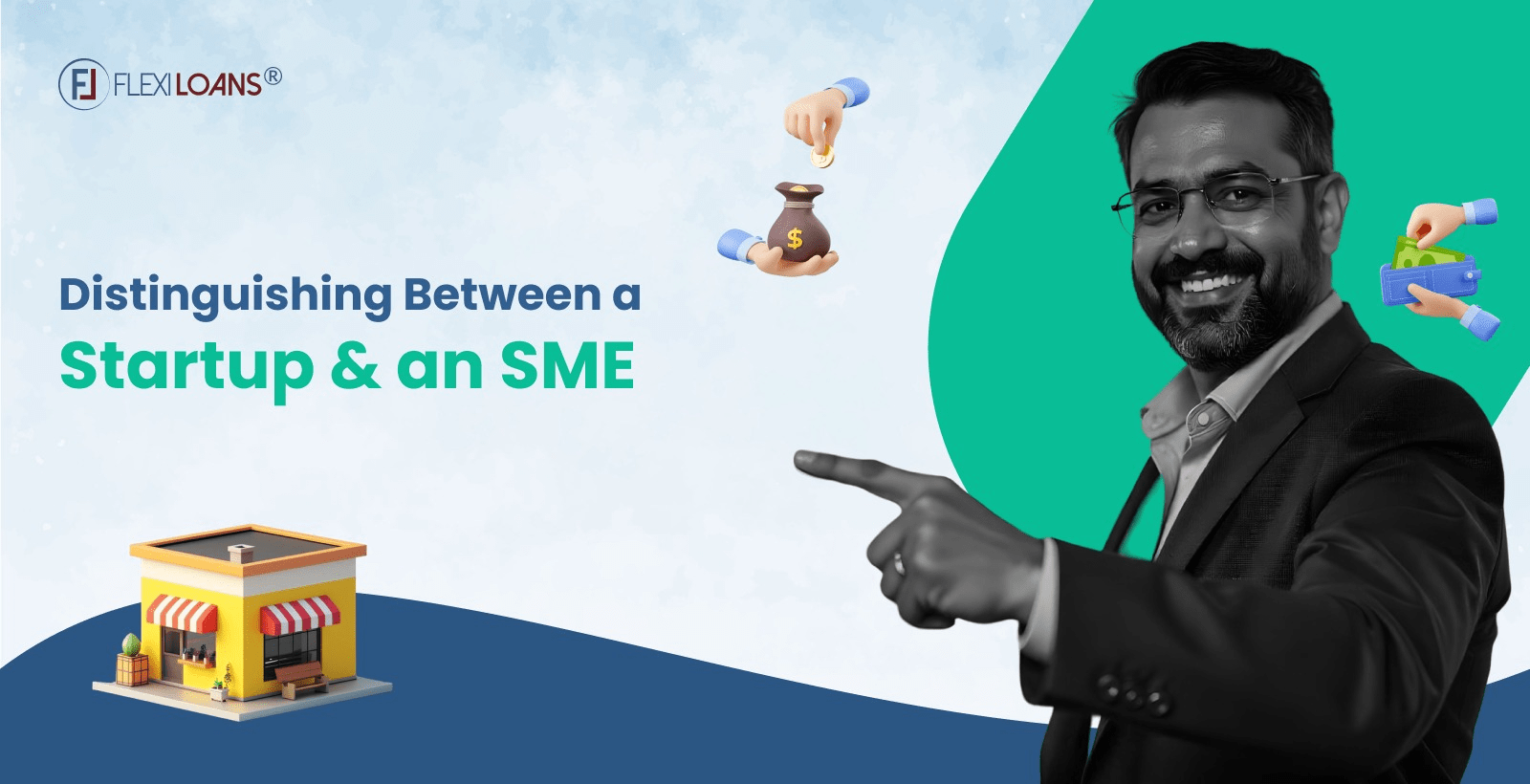Aug 27, 2024
Oct 01, 2025

Understanding the distinctions between a Startup and a Small and Medium Enterprise (SME) is crucial for anyone involved in the business world. Whether you’re an entrepreneur looking to kickstart a new venture or a small business owner aiming for growth, knowing these differences can help you make informed decisions about your business strategy, funding options, and scalability.
What is a Startup?
A Startup is a young company founded to develop a unique product or service and bring it to market. Startups are typically characterised by their focus on innovation, scalability, and a high potential for rapid growth. Unlike traditional businesses, Startups often begin with a small team and rely heavily on external funding to fuel their expansion.
Characteristics of a Startup
1. Innovation: Startups are built around innovative ideas that solve specific problems or fill market gaps. This innovation can be in the form of new products, services, or business models.
2. Scalability: Startups aim for rapid growth and scalability. They often leverage technology to expand their operations and reach a larger customer base quickly.
3. Funding: Startups typically require significant capital to develop their products and grow. This funding often comes from venture capitalists, angel investors, or crowdfunding platforms.
4. Risk and Reward: Startups operate in a high-risk, high-reward environment. While the potential for substantial returns exists, the failure rate is also high.
5. Dynamic Culture: Startups often have a dynamic and flexible work culture. They encourage creativity and innovation, allowing employees to experiment and take risks.
What is an SME?
Small and Medium Enterprises (SMEs) are businesses that maintain revenues, assets, or a number of employees below a certain threshold. SMEs play a vital role in the economy, contributing significantly to employment and GDP. They include a wide range of businesses, from local shops to manufacturing firms.
Characteristics of an SME
1. Size and Scale: SMEs are typically smaller in size compared to Startups, with a focus on steady and sustainable growth rather than rapid expansion.
2. Funding: SMEs usually rely on traditional funding sources such as bank loans, government grants, and internal profits. They may also explore options like machinery loans to support their operational needs.
3. Stability: SMEs often operate in well-established markets with stable demand. Their business models are usually less risky compared to Startups.
4. Local Focus: Many SMEs have a strong local or regional focus. They cater to specific communities and build loyal customer bases within those areas.
5. Business Model: SMEs often have conventional business models with a focus on profitability and long-term sustainability.
Also read about How to get MSME Loan
Differences Between a Startup and an SME
1.Business Objective
The business objectives of startups and SMEs differ fundamentally due to their nature and goals.
Startup Objectives:
- Innovation: Startups are driven by the desire to create innovative products or services. Their primary objective is to solve problems in new and inventive ways, often leveraging cutting-edge technologies.
- Rapid Growth: A startup’s goal is to achieve rapid scaling and market penetration. They aim to grow quickly to capture a significant market share and establish themselves as leaders in their industry.
- Market Disruption: Startups seek to disrupt existing markets or create new ones by introducing novel solutions that challenge traditional business practices.
SME Objectives:
- Sustainable Growth: SMEs focus on achieving steady and sustainable growth over time. Their objectives include expanding their market presence gradually and maintaining long-term profitability.
- Local Market Focus: Many SMEs cater to local or regional markets, prioritising customer relationships and community engagement. Their growth strategies often involve deepening their presence in these markets rather than pursuing global expansion.
- Community Impact: SMEs play a significant role in local economies by providing stable employment and supporting community initiatives. Their business objectives often include contributing positively to their local environments and economies.
2. Funding and Control
The funding and control structures for startups and SMEs differ due to their varying stages of development and growth objectives.
Startup Funding:
- Venture Capital: Startups frequently seek funding from venture capital (VC) firms, which invest capital in exchange for equity stakes. VC funding is crucial for startups that need significant resources to scale quickly and develop their products.
- Angel Investors: Angel investors are high-net-worth individuals who provide early-stage funding to startups in exchange for equity or convertible debt. Their investment helps startups bridge the gap between initial seed funding and later-stage venture capital.
- Crowdfunding: Many startups use crowdfunding platforms to raise capital from a large number of small investors. This approach allows startups to generate funds while simultaneously building a customer base and validating their business model.
SME Funding:
- Bank Loans: SMEs often secure funding through traditional bank loans, such as working capital loans and term loans. These loans are typically used for business expansion, equipment purchases, or operational needs.
- Government Initiatives: Various government schemes support SMEs with financial assistance and incentives. MSME loans, for example, are designed to help small and medium-sized businesses access affordable financing. Additionally, small business loans and collateral-free business loans are available to support SMEs in their growth efforts.
- Self-Funding: Many SMEs rely on self-funding or reinvested profits to finance their growth. This approach helps maintain control over the business without diluting ownership or taking on additional debt.
Control:
- Startups: Due to their reliance on external investors, startups often have less control over their business decisions. Investors may influence strategic choices, operational approaches, and management structures.
- SMEs: Owners of SMEs typically retain full control over their businesses. They make strategic decisions independently, without the influence of external equity investors.
3. Risk Factor
The risk factors associated with startups and SMEs reflect their different business models and market approaches.
Startup Risks:
- High Failure Rate: Startups face a high risk of failure due to their innovative nature and the uncertainty of new markets. The lack of a proven business model and intense competition contribute to this risk.
- Market Uncertainty: Entering new or uncharted markets introduces substantial risks. Startups must navigate unknown challenges and adapt quickly to changing market conditions.
- Funding Challenges: Securing continuous funding can be difficult for startups, especially if initial growth projections are not met. The need for ongoing capital to support rapid expansion can strain financial resources.
SME Risks:
- Economic Dependency: SMEs are often more vulnerable to local economic conditions. Economic downturns or regional challenges can significantly impact their operations and profitability.
- Limited Scalability: The traditional business models of SMEs may limit their scalability and growth potential. They may face challenges in expanding beyond their local or regional markets.
- Regulatory Challenges: SMEs must comply with local regulations and policies, which can be complex and time-consuming. Regulatory changes or compliance issues can affect their operations and costs.
- Startups: Investors often have significant control over business decisions due to their equity stakes.
- SMEs: Owners of SMEs usually retain full control over their business, making decisions independently.
4. Innovation and Market Approach
Startup: Focuses on innovation and market disruption. Startups often introduce new products, services, or business models that challenge existing market players.
SME: Emphasises steady growth and stability. SMEs usually operate in established markets with a focus on improving existing products and services.
5. Scalability
Startup: Designed for scalability. Startups aim to expand rapidly and reach a large customer base quickly.
SME: Growth is more controlled and steady. SMEs focus on sustainable expansion and often have a strong local or regional presence.
Government Initiatives and Support
Governments worldwide recognise the importance of both Startups and SMEs to the economy. In India, various initiatives support these businesses:
Startups: Programs like Startup India offer funding support, tax benefits, and easier compliance regulations to foster innovation and growth.
SMEs: Schemes such as the Credit Guarantee Fund Trust for Micro and Small Enterprises (CGTMSE) provide credit guarantees, making it easier for SMEs to obtain loans for business needs.
Business Registration and Compliance
The process of registering a business can differ significantly for Startups and SMEs:
Startups: Often opt for private limited company structures to attract investors. The registration process can be more complex, requiring compliance with various regulations.
SMEs: May register as sole proprietorships, partnerships, or limited liability partnerships (LLPs). The registration process is usually simpler, with fewer compliance requirements.
How to Choose Between a Startup and an SME Model
Deciding whether to pursue a Startup or an SME model depends on your business goals, risk tolerance, and funding access. Here are some considerations to help you decide:
1. Business Goals: If you aim for rapid growth and market disruption, a Startup model might be suitable. If you prefer steady, sustainable growth, an SME model may be better.
2. Risk Tolerance: Startups come with higher risks and potential rewards. If you are comfortable with high stakes and uncertainty, consider a Startup. If you prefer stability and predictability, an SME is a safer choice.
3. Funding Access: Assess your ability to secure funding. Startups often need significant external investment, while SMEs can rely on traditional funding sources.
4. Innovation: If your business idea involves a high level of innovation and technology, a Startup model can help you achieve your goals. If your focus is on improving existing products and services, an SME model is more appropriate.
Also read about How to get Startup India Scheme
The Role of technology in Startups and SMEs
Technology adoption is a critical differentiator between startups and SMEs.
Startup Technology:
- Innovation-Driven: Startups leverage cutting-edge technologies to create innovative solutions.
- Digital-First Approach: Many startups adopt a digital-first approach, integrating technology into all aspects of their business operations.
- Scalability: Technology enables startups to scale rapidly and efficiently.
SME Technology:
- Incremental Adoption: SMEs typically adopt technology incrementally, often focusing on cost-effective solutions.
- Operational Efficiency: Technology adoption in SMEs aims to improve operational efficiency and productivity.
- Local Solutions: SMEs may implement technology that caters specifically to their local market needs.
The Importance of Innovation
Innovation is at the heart of Startups. They often introduce new technologies, products, or services that disrupt existing markets. This focus on innovation allows Startups to capture market share quickly and establish themselves as leaders in their industry.
SMEs, on the other hand, may not always prioritise innovation to the same extent. While they can be innovative, their primary focus is usually on improving existing products and services to meet customer needs. This approach helps SMEs build a loyal customer base and maintain steady growth.
Conclusion
Whether you choose to build a Startup or an SME, understanding their unique characteristics and differences is crucial. Each model offers distinct advantages and challenges, and the right choice depends on your business goals, risk tolerance, and funding access. Remember, FlexiLoans can help you secure the necessary funding, whether you need quick business loans or machinery loans to grow your business.
With this comprehensive understanding, you’re now better equipped to make informed decisions about your business journey. Whether you aim for the rapid growth of a Startup or the steady, sustainable expansion of an SME, the right approach will pave the way for your success.
FAQs
Understanding the differences helps you choose the right business model, funding options, and growth strategies.
While an SME can adopt innovative practices, the fundamental differences in growth objectives and funding sources usually keep them distinct.
Startups typically rely on venture capital and angel investors, while SMEs use bank loans, government grants, and internal profits. FlexiLoans offers easy access to loans for both Startups and SMEs, making it easier to get your business loan sanctioned.
Programs like Startup India and CGTMSE provide funding support, tax benefits, and easier compliance regulations to foster growth and innovation.
It depends on your business goals, risk tolerance, and funding access. Consider your objectives and choose the model that aligns with your vision.







